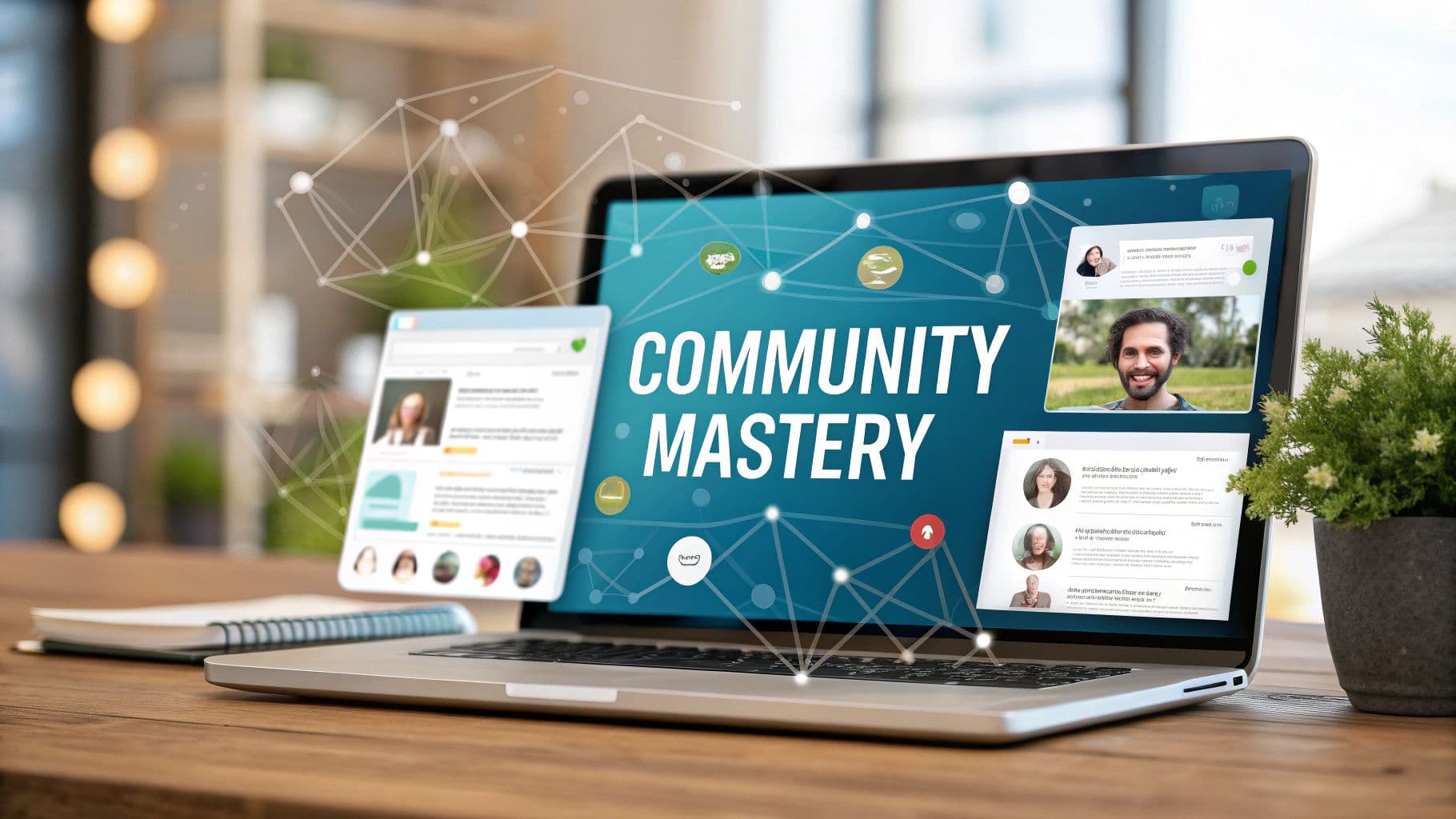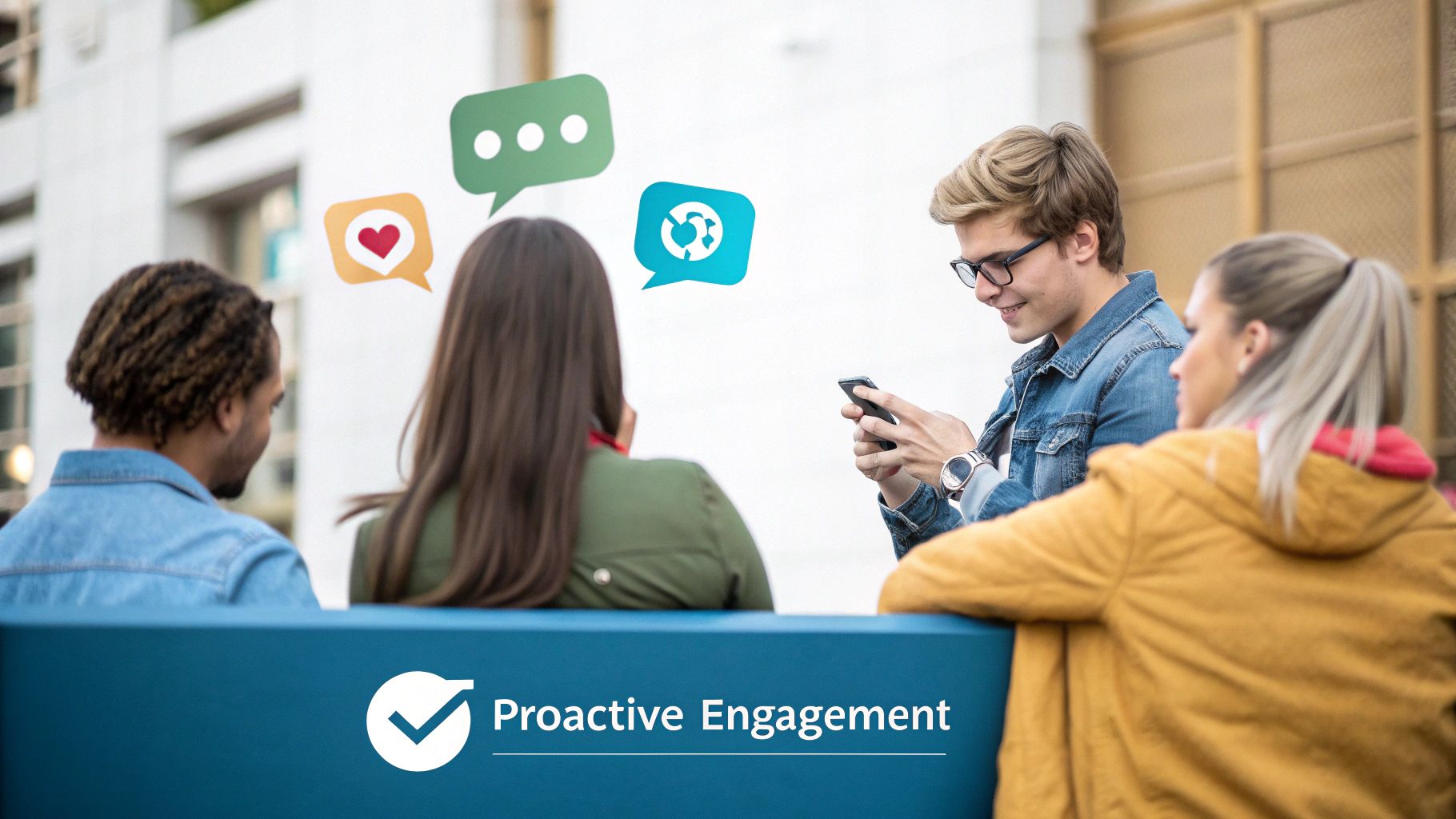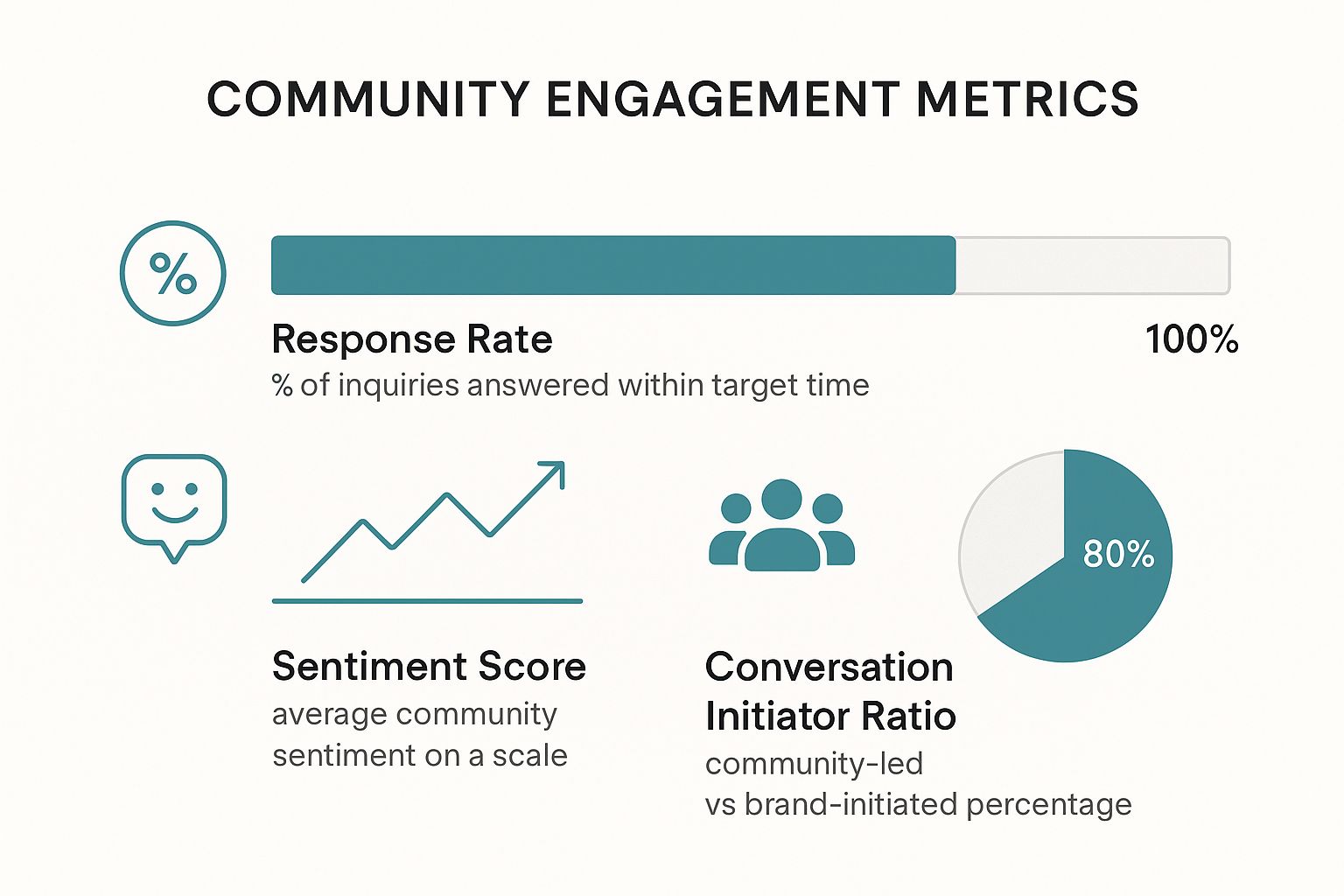
Let's get one thing straight, founder-to-founder: social media community management isn't about fluffy posts or vanity metrics. It's about turning a passive audience into a loyal tribe that genuinely cares about what you're building. It's about building a moat around your brand that competitors can't touch.
What Is Social Media Community Management, Really?

Think of yourself as the host of a great dinner party. You don't just send invites and hope people have fun. You greet them, make introductions, spark conversations, and ensure everyone feels valued. That's social media community management. It’s the difference between broadcasting at people and building with them.
While a social media manager pushes out a content calendar, a community manager is obsessed with relationships. It’s a long game—a commitment to earning trust and encouraging connections, not just with your brand, but between the members themselves.
Moving Beyond Simple Management
This is where the real work begins. We see this role as a proactive one, built on three foundational pillars that shift the focus from merely managing a page to actively building a community.
- Proactive Engagement: Don't wait for mentions. We're out there, finding relevant conversations and adding real value without a hint of a sales pitch.
- Deep Listening: This is more than monitoring notifications. It’s tuning into the sentiment, pain points, and aspirations of your audience. This is where you find unfiltered product feedback.
- Creating Value Beyond the Product: The community itself becomes the product. You're creating a space where members can connect with peers, learn from one another, and find genuine support.
The goal is to make your brand the facilitator of a thriving ecosystem, not just the subject of it. When done right, your community becomes a powerful moat that competitors can't easily replicate.
This shift in mindset is absolutely critical. After all, a huge 48.7% of users are on social media primarily to connect with other people, not to be sold to by brands. When you foster those genuine human connections, you're aligning your entire strategy with why people are there in the first place.
To dig deeper into the groundwork of building these kinds of spaces, check out these great tips on how to build an online community. This approach turns your social media presence from a simple marketing channel into a lasting asset that fuels both loyalty and growth.
Our Tech Stack for Monitoring Online Communities
As a founder, you can't just hang out on your own social pages. The real, unfiltered conversations—the ones that are pure gold—are happening on Reddit, X, and niche forums. At BillyBuzz, we built a listening engine that lets our small team tap into these discussions without getting buried in noise.
Our philosophy is surgical precision. We don’t try to monitor the entire internet; that’s a fast track to burnout. Instead, we zero in on the digital spaces where founders and marketers actually spend their time.
The Core Tools in Our Workflow
Our stack is intentionally lean. It's built around a few key tools that give us the most signal for the least noise.
- Brand24 for Broad Monitoring: This is our dragnet. We use it to catch mentions of "BillyBuzz," track competitors, and monitor keywords tied to social listening and Reddit marketing.
- BillyBuzz for Deep Reddit Insights: We use our own tool for Reddit. While Brand24 gives us a wide view, BillyBuzz is our microscope for digging into subreddit conversations. Its AI-powered relevancy scoring is the secret sauce that finds high-intent discussions simple keyword matching would miss.
- Slack for Real-Time Alerts: All roads lead to Slack. We pipe alerts from both Brand24 and BillyBuzz directly into dedicated channels (
#brand-mentions,#reddit-leads). The team can jump on an opportunity and craft a response without switching apps.
Here’s a look at how we set up Brand24 to cut through the clutter. The key is using both required keywords and negative filters.
This filtering is what turns a monitoring tool from a constant distraction into a useful lead-gen machine.
Our Specific Alert Rules and Filters
The tools are only half the battle; the real magic is the setup. We've spent months fine-tuning our alert rules to pull out high-priority conversations our small team can realistically act on.
We treat our monitoring setup like a sales funnel. The goal is to progressively qualify conversations, so our team only spends time on interactions that have the highest potential for impact.
Today, AI is a non-negotiable part of this process. A recent report actually found that 89% of social media managers now use AI tools in their daily workflows. This isn't just about creating content anymore; AI is fundamental for smart analytics and intelligent monitoring. You can learn more about this shift by checking out the insights on how AI is shaping social media strategies on heyorca.com.
If you're just getting started, picking the right software can feel overwhelming. We've put together our top picks in our guide to the top social monitoring tools for startups in 2024. This workflow is what allows us to handle a huge volume of online mentions efficiently, turning our monitoring stack into a real engine for growth.
The BillyBuzz Playbook for Proactive Engagement

Great community management is playing offense. If you just wait for someone to tag your brand, you’re missing the real conversations. You’re waiting for customers to wander into your store instead of going to where they are.
At BillyBuzz, our strategy is built around getting into the right conversations before they find us. We become a familiar, helpful voice where our audience already hangs out.
Our Monitoring Hotspots
You can't be everywhere. We learned that the hard way. Now, we focus on a handful of high-impact subreddits where we know founders are looking for real advice.
Our daily hit list is short and sweet:
- r/startups: Goldmine for the raw, unfiltered challenges new founders face.
- r/SaaS: Go-to spot for serious discussions on growth, churn, and product.
- r/marketing: Broader community, but valuable for spotting trends and pain points.
- r/Entrepreneur: Similar to r/startups, with more focus on the founder journey.
We don't just browse. We use our own tool, BillyBuzz, to filter for keywords like "customer feedback," "finding users," "Reddit marketing," and "social listening tools." The goal is never to barge in with a sales pitch. It’s about answering a question and offering a genuine perspective.
The philosophy is simple: Give more than you take. When you consistently provide value without asking for anything in return, you build trust and authority. Over time, people start seeking you out.
Our Go-To Response Templates
Having a few solid templates helps us respond quickly and consistently without sounding like robots. These are starters, not scripts. They provide a framework for a genuine response.
Scenario 1: Answering a Technical Question
- Template: "Great question. We ran into a similar challenge. Here's the framework that helped us: [Step 1, Step 2]. The key was realizing [specific insight]. Hope that helps you get unstuck!"
- Why it works: Shows empathy ("we've been there"), provides direct value, and positions us as experienced peers.
Scenario 2: Adding Value to a Pain Point Discussion
- Template: "I see a lot of people struggling with [pain point]. One thing that's often overlooked is [counterintuitive advice]. It feels small, but it can make a big difference because [reasoning]."
- Why it works: Directly addresses the problem, offers a unique insight that builds authority, and avoids the generic "we can help" pitch.
Scenario 3: Responding to a Competitor Mention
- Template: "They're a great tool for [specific use case]. If you're looking for something that specializes more in [our niche/feature], that's where we focus. Either way, the key is to find a workflow that sticks."
- Why it works: It's respectful, highlights our unique value prop without being aggressive, and keeps the focus on helping the user.
To give you a clearer picture of how this works day-to-day, here's a look at our team's cheatsheet.
BillyBuzz Proactive Engagement Cheatsheet
| Platform | Example Subreddits/Keywords | Primary Goal of Interaction | Response Starter Template |
|---|---|---|---|
r/startups - "first 100 users", "getting feedback" |
Provide actionable advice from our own experience. | "This is a classic hurdle. When we were at this stage, we found that focusing on [specific tactic] was a game-changer..." | |
r/SaaS - "reduce churn", "product marketing" |
Share a unique perspective or a helpful resource. | "Seeing a lot of good points here. One angle that's often missed is [counterintuitive insight]. This article explains it well..." | |
r/marketing - "social listening tools", "brand monitoring" |
Answer questions and build authority on our topic. | "Great question! When choosing a tool, the most important factor is often [key feature], not just price. For example..." |
This simple table keeps our team aligned and ensures we’re consistently adding value wherever we show up.
A solid workflow is what makes this proactive approach possible every single day. For a deeper dive, check out our checklist for effective social media engagement. And if you want to see how other brands are crushing it, these community engagement strategy examples are a great source of inspiration.
How We Turn Negative Feedback into Growth
https://www.youtube.com/embed/lRyduXZSblk
Let’s be honest, negative feedback can feel like a punch to the gut. The first instinct is often to delete the comment and move on. That’s the quickest way to destroy the trust you’re trying to build.
At BillyBuzz, we see criticism differently. It’s a free consulting session from the people who matter most: our users.
These comments are gold. They pinpoint exactly where our product has friction, where our messaging is confusing, or where the customer experience is broken. Deleting a comment makes the problem disappear for a minute; addressing it head-on can build a loyal fan for life.
Our A-E-I-R Framework for Responding
To handle tough feedback the right way, every time, our team uses a simple, four-step framework. It’s a genuine approach for turning a bad moment into something productive.
Acknowledge: First, validate their feeling in public. “Thanks for bringing this to our attention” shows you’re listening, not getting defensive. It immediately de-escalates the situation.
Empathize: Connect with their frustration. “I can see why that would be frustrating” or “That’s definitely not the experience we want for you” proves you’re on their side.
Investigate: Take the conversation private. Say something like, “I’m sending you a DM to get some details so our team can dig into this.” This protects their privacy and signals you're taking action.
Resolve: After you’ve sorted it out behind the scenes, follow up on the original public thread. “Just wanted to close the loop—we found the bug and a fix is on the way. Thanks again for flagging this!” shows everyone you follow through.
We once had a user publicly complain about a bug in their alerts. Instead of arguing, we used the A-E-I-R model. We DMed them, got the specifics, and our dev team pushed a fix in 24 hours. That user edited their original comment to praise our speed, turning a complaint into a killer testimonial.
This process is more than just putting out fires. We log every piece of feedback in a dedicated Slack channel and tag it (#bug-report, #feature-request, #ux-feedback). This turns customer complaints into an incredible resource for our product team and ensures the voice of our community is baked directly into our roadmap.
Measuring Community Health Beyond Vanity Metrics
It's tempting to chase follower counts and likes. They feel good, but they don't tell you anything about the health of your community. We learned early on to look past these vanity metrics and focus on numbers that show real connection.
True community management isn't about broadcasting to a massive, silent audience. A huge follower count with crickets in the comments is just a digital billboard; a smaller, buzzing community is an engine for growth. When you track the right data, your social strategy stops being a cost center and becomes a measurable driver for your business.
The infographic below highlights the core metrics we use to take our community's pulse.

This data paints a clear picture: a community that's responsive, feels positive, and is starting to sustain itself. These are the signs of a healthy online space.
The Metrics We Actually Track
We run a simple health check-in each week. It's not complicated. We focus on a few key performance indicators that tell the real story.
- Response Rate: Non-negotiable. The percentage of questions and mentions that get a timely reply. It shows you’re listening and proves every voice matters.
- Sentiment Score: We use tools to analyze conversations and assign a sentiment score—positive, neutral, or negative. Watching this trend tells us if our work is building goodwill. You can learn more about how AI helps measure social media engagement in our guide.
- Conversation Initiator Ratio: The most powerful metric of all. It's the ratio of conversations started by us (the brand) versus those started by community members. When members start asking their own questions and helping each other, you’ve built something real.
From Vanity to Vitality
Switching your focus from surface-level numbers to deeper community health indicators is a game-changer.
| Metric Type | Vanity Metric Example | Community Health Metric Example | What It Actually Tells You |
|---|---|---|---|
| Reach | Follower Count | Share of Voice | How many people see your brand vs. how much of the conversation your brand owns compared to competitors. |
| Engagement | Likes per Post | Comments per Post | How many people passively approve vs. how many are actively participating in the discussion. |
| Responsiveness | Number of Mentions | Response Rate | How many people are talking at you vs. how well you’re participating in conversations with them. |
| Advocacy | Brand Hashtag Usage | User-Generated Content (UGC) | How many people use your tag vs. how many are so inspired they create content on your behalf. |
This shift helps you see that a healthy community isn't just a marketing asset; it's a core strategic advantage.
Why This Data Drives Growth
Focusing on these deeper metrics gives you insights you can actually use. A dip in sentiment score could be an early warning about a product flaw. A falling response rate is a sign your team is overwhelmed. And a rising number of community-led discussions? That's the ultimate signal of trust.
A healthy community isn't just a marketing asset; it's a strategic advantage. It provides unfiltered feedback, builds a protective moat around your brand, and creates powerful social proof that advertising can't buy.
This isn't just theory—it has a real impact on the bottom line. According to research from Sprout Social, 90% of local businesses are active on social media, and 78% report that these efforts directly bring in revenue. By measuring what truly matters, you can ensure your community management work contributes directly to that growth.
Building a Sustainable Community Management Workflow

As a founder, your time is your most precious resource. Effective social media community management can't be a chaotic, "when-I-get-to-it" task. It needs a system. If it isn't a repeatable process, it won't get done consistently.
At BillyBuzz, we built a workflow that prevents burnout and turns community growth into a reliable daily habit. We don’t "log on when we have time." We treat engagement like any other critical business function: with structure and purpose.
Our Time-Blocking Strategy
The secret is working in focused sprints. This stops us from falling down the endless scroll rabbit hole, which can devour a founder’s day. A disciplined schedule is the only way a small team can make a big impact.
Our daily calendar has two sacred blocks of time:
- Proactive Outreach (30 minutes): First thing in the morning. We jump into our target subreddits, looking for conversations where we can genuinely add value, not just pitch.
- Inbound Response (30 minutes): In the afternoon. We tackle all direct mentions, comments, and questions. Batching them is far more productive than reacting to every notification.
This isn't about spending more time online; it's about making the time you spend truly count. A structured 60 minutes of focused work will always beat five hours of scattered, reactive monitoring.
Centralizing Alerts with Slack
To make our time blocks work, we need all intel in one place. We use tools like Brand24 and our own BillyBuzz tool to funnel every alert into dedicated Slack channels like #brand-mentions and #reddit-leads.
This setup is our command center. When an opportunity pops up, the team can huddle in the Slack thread to craft the perfect response. It kills the need to constantly switch apps and helps us move fast.
By combining disciplined time-blocking with a smart tech stack, we've built a community management workflow that actually scales. It turns a potential mess into a manageable—and highly effective—daily routine.
Burning Questions Answered
As founders ourselves, we're constantly asked how to make social media community management click without a giant team. We get it. Here are the most common questions we get, with our straight-to-the-point answers.
How Much Time Do I Really Need to Spend on This Every Day?
Forget being online 24/7. That's a fast track to burnout. We see incredible results from just 60 minutes of focused work a day.
The trick is our time-blocking method: 30 minutes in the morning for proactive engagement in subreddits like r/SaaS, and another 30 minutes in the afternoon to handle mentions and replies. This creates a sustainable habit and keeps community management from taking over your day.
Should I Chase Follower Numbers or Focus on Engagement?
Engagement. Every single time. A small, active community is worth far more than a massive, silent audience. High engagement is proof you're building real connections. That’s why we obsess over metrics like our response rate and the conversation initiator ratio (how many posts are started by the community versus us). Those numbers tell the real story.
Is It Okay to Automate Responses to Be More Efficient?
Please, don't. Never automate your conversations. People can sniff out a robot a mile away, and it shatters trust.
Where automation is a game-changer is in monitoring. We have Slack alerts set up for keywords like "social listening tools" or competitor names. This frees us from constantly searching and lets us focus our energy on writing thoughtful, human replies. Use automation to find the conversation, not to have it for you.
Ready to stop manually scrolling through Reddit and start finding customers who are ready to talk? BillyBuzz uses AI to keep an eye on relevant conversations and sends you real-time alerts. You'll know exactly when to jump in and join the perfect discussion. Find your next customer at BillyBuzz.com.
